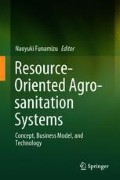Abstract
Composting toilet has a characteristic that it has possibility to stock pathogens for a while when the patient uses it. Then health hazard aspects must be considered in the case of composting toilet more than water flush type. In this chapter, the typical and important pathogenic microbes relating to composting toilet are introduced. And the fate of model microbes which indicates pathogenic microbes in composting toilet was shown here. The decreasing rate of them depends upon the operating condition. We have to consider what appropriate conditions for enhancing reduction of pathogens are, and the quantitative microorganism risk assessment (QMRA) method is explained here to consider the acceptable risk when we handled the material such as sawdust. Based on QMRA consideration, the required reduction level is revealed, and the appropriate indicator microbes are suggested for monitoring high-tolerant pathogens in compost. In addition, the methods to estimate the inactivation mechanisms of microbes in compost are suggested in this chapter.
Access this chapter
Tax calculation will be finalised at checkout
Purchases are for personal use only
References
Burge WD, Colacicco D, Cramer WN (1981) Criteria for achieving pathogen destruction during composting. J Water Pollut Con F 53(12):1683–1690
Craig DL, Fallowfield HJ, Cromar NJ (2002) Comparison of decay rates of fecal indicator organisms in recreational coastal water and sediment. Water Supply 2(3):131–138
Haas CN, Rose JB, Gerba CP (1999) Quantitative microbial risk assessment. Wiley, USA
Hung RT (1993) The practical handbook of compost engineering. CRC Press, United States
Kazama S (2010) The inactivation mechanisms of bacteria and viruses in excrement treatment using sawdust. Ph.D thesis, Ochanomizu University (in Japanese)
Kazama S, Otaki M (2010) Fate of indicator bacteria for pathogenic viruses in composting toilet. J Jpn Soc Civil Eng Ser G 66(4):179–186. https://doi.org/10.2208/jscejg.66.179 (in Japanese)
Kazama S, Otaki M (2011) Mechanisms of bacteria and viruses inactivation in sawdust used in composting toilet. J Water Environ Technol 9(1):53–66. https://doi.org/10.2965/jwet.2011.53
Kazama S, Otaki M (2012) Inactivation mechanisms of E. coli in the sawdust used in composting toilet. J Water Environ Technol 10(4):363–374. https://doi.org/10.2965/jwet.2012.363
Kazama S, Tameike N, Nakagawa N, Otaki M (2011) A fate model of pathogenic viruses in a composting toilet based on coliphage inactivation. J Environ Sci 23(7):1194–1198. https://doi.org/10.1016/S1001-0742(10)60490-1
Nakagawa N, Yamagoshi K, Oe H, Otaki M (2003) Microbial risk assessment of the composting toilet. J Environ Syst Eng 748/VII-29:91–98 (in Japanese)
Nakagawa N, Oe H, Otaki M, Ishizaki K (2006) Application of microbial risk assessment on a residentially-operated bio-toilet. J Water Health 4(4):479–486
Otaki M, Nakagawa N, Akaishi F, Kubo K (2006) The fate of microorganisms in the composting toilet from the view point of hygienic risk. In: Proceedings of the 2nd international dry toilet conference. Tampere, Finland, vol 68, pp 16–19
Otaki M, Nakagawa N, Kazama S, Akaishi F, Tameike S (2007) Hygienic risk assessment and control in using composting toilet. In: Proceedings of the 5th international symposium on sustainable sanitation, pp 163–170
Prüss-Üstün A, Bos R, Gore F, Bartram J (2008) Safer water, better health. WHO Publishing, Geneva
Sobsey M, Battigelli DA, Handzel TR, Schwab KJ (1995) Male-specific coliphages as indicators of viral contamination of drinking water. AWWA Research Foundation, USA
WHO and Unicef (2012) Progress on drinking water and sanitation. WHO Publishing, Geneva
Author information
Authors and Affiliations
Corresponding author
Editor information
Editors and Affiliations
Rights and permissions
Copyright information
© 2019 Springer Japan KK, part of Springer Nature
About this chapter
Cite this chapter
Otaki, M., Kazama, S. (2019). Fate of Pathogens in Composting Process. In: Funamizu, N. (eds) Resource-Oriented Agro-sanitation Systems. Springer, Tokyo. https://doi.org/10.1007/978-4-431-56835-3_5
Download citation
DOI: https://doi.org/10.1007/978-4-431-56835-3_5
Published:
Publisher Name: Springer, Tokyo
Print ISBN: 978-4-431-56833-9
Online ISBN: 978-4-431-56835-3
eBook Packages: Earth and Environmental ScienceEarth and Environmental Science (R0)

